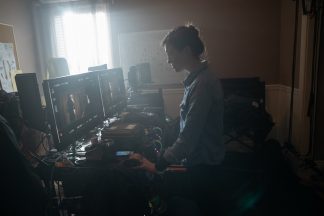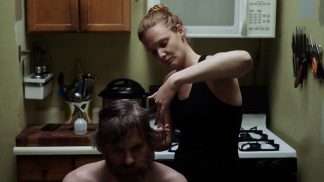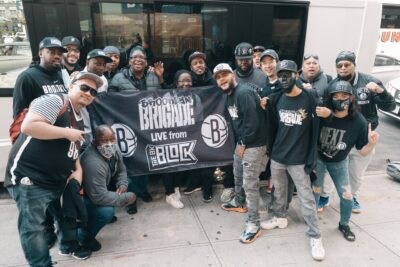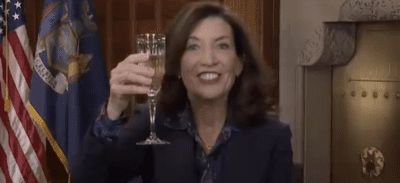'The Flight Attendant,' courtesy Warner Media
‘It was triage’: What it’s like to film in the middle of a pandemic
From 'Covid officers' to auditioning via Zoom, five industry professionals share what’s changed—and what hasn’t
Hillary Fyfe Spera lives in Red Hook, the neighborhood that’s also home to Sunny’s Bar, Pioneer Works, Hometown BBQ and a Hitchcockian amount of seagulls. It’s undoubtedly one of the borough’s more mystic areas.
Unlike most locals during this WFH era, Spera, a cinematographer with credits such as “Heaven’s Gate: The Cult of Cults” (HBO Max), has actually traveled for work in recent months. In early January, she was in Devens, Mass., for an in-production Showtime pilot. On a video call for this article, Spera was wearing a face mask because her colleagues were milling around in their shared space. They were plotting, she said, “very Fargo” winter scenes. The very idea of “Fargo” and all it conjures seems apropos for this whole pandemic; it’s been a nonstop blizzard of WTF?s and FFSs.
“I can’t just go and hug my crew member or interact in that way,” Spera said. “And so it feels a bit colder and a little foreign.”
Nonetheless, New Yorkers have endured. With that in mind, Brooklyn Magazine interviewed some of our local Hollywood scene-makers who have labored on Zoom, dealt with previously unimaginable circumstances and still somehow managed to push out work in recent months. We wanted to see how they’ve done it creatively and technically, spotlighting five roles: cinematographer, script supervisor, actor, editor and director-actor.

Spera at work/home (photo: Allan Fraser)
Mitigating frustration
In early fall, Spera worked on the final two episodes of Season 1 for the buzzy HBO drama “The Flight Attendant.” The precautions around productions have been next-level, due to health concerns, union protocol and the expensive talent on hand.
Spera, 39, has had to adapt. The cinematographer’s role on set is to help realize the director’s larger vision by making the marriage of art and technology as seamless as possible.
“We’re using a lot of more remote [camera] heads as opposed to cameras close to the actors,” Spera explained. “Handheld is always a thing, because the operators need to be able to get the camera close to the actors. When we are wearing a mask and goggles, that’s a challenge.”
Anyone who has been wearing glasses with a mask outdoors knows about the fogginess. Imagine if your one job is to get that shot but you can barely see right in front of you.
When Spera and her colleagues are virtually doing prep and post work, in order to keep everyone safe, there are Zoom calls from 7 a.m. until 7 p.m. Email and text messages can overwhelm but have reasonably taken the place of working in person when consulting with the director, story-boarding, and so forth.
“The hardest thing I think is mitigating the frustration,” Spera said. “You really have to be understanding, because it sucks wearing this [mask] all day and screaming through it. And you’re sweating. And it’s not fun; it’s not cute. But we try and find a way to make it fun. And I feel really lucky that I’m with a crew that really gets it.”
Supervising from six feet
Last March, more than a week before her producers shut down production of FOX’s crime thriller, “Prodigal Son,” veteran script supervisor Diane Hounsell was on WhatsApp with her Milan-based cousin, who was giving her dispatches from a country already stricken with Covid. “She told me, ‘I started working from home February 9th’,” she said. “I remember thinking, ‘Huh, they’re a couple of weeks ahead with the virus—so that’s what’s in store for us.”
Hounsell continued, “So on March 13th, they called a big meeting and said, ‘Well, this will be our last day for a while. We’re hoping to shut down just for two weeks.’ And I thought, ‘We’re not going to come back to work until September.’”
It was actually early October when “Prodigal Son” began shooting again. On set, color-coded safety zones—red, yellow and green—were established to operationalize physical distancing. These zones have become protocol across the industry during the pandemic.
“The red zone is the people who can be closest to the actors, including the director and the [director of photography],” Hounsell said. “While normally I would be close to the actors, I am in the yellow zone, which is a subdivision of the red zone. Which means that if I go on set to talk to the actors, I have to stay six feet away from them.”
A script supervisor’s duties include making sure actors get their lines right and blocking correct; communication between the two parties is constant. And with everyone wearing masks and goggles and staying six feet apart, awkward moments creep in.
“They don’t want everybody to know that they forgot a line,” Hounsell said. “Normally, what I would do, if they had made a mistake, is run out to set after a take, and say to them, ‘You said this, but this is what the line is instead.’ Now, I either have to call it out from a distance, which is calling out their mistake to everybody on the whole set, or I have to tell the first [assistant director] to go and tell the actor.”
Before the pandemic, Hounsell said she’d share a monitor with either the director or both the director and the director of photography. “When I went back to work, I had my own monitor,” she said. “And production got a bunch of iPads for others like the wardrobe and the makeup people who normally would also cluster around a single monitor.”
The daily activities on set are also different now. Everyone gets tested four times a week, with three being PCR tests and one rapid. At lunchtime, there are no craft services. No chowing down together at tables. They get sack lunches and eat alone at a bench or another spot that works out comfortably enough.
Hounsell, who lives on the Upper East Side, went back to work on the second season of “Prodigal Son” the week of January 5. After last fall, she’s gotten used to how things have to be done, but looking back to October, it all felt a little dystopian.
“There were Covid officers on set who were wearing red vests, and some of them walked around with these long six foot tall poles that they can use to measure out distances,” she said. “And if they see people clustering too closely together, they say, ‘Six feet apart! Six feet apart!’”
Killing it up and down the coast (and on Zoom)
During the pandemic, comedian and actor Nore Davis has split time between his Bed-Stuy apartment and his dad’s house in Yonkers, where he grew up. Through his agent, he landed his first post-lockdown job on a Lotto commercial in Richmond, Va., in July, and no one on set knew what to expect because the national vibe was still, as Davis put it, “Is the air poisoned?”
“Then, we knocked that spot out,” Davis said. “From there, I realized, “OK, this can be done.’”


Davis, left, in ‘Balcony’
The 36-year-old has appeared in notable TV series including “Succession” and “Boardwalk Empire” (both on HBO) and “Inside Amy Schumer” (Comedy Central). Davis last fall appeared in “A Balcony in Brooklyn,” an eight-minute dramatic short written and co-directed by award-winning producer Dennis Williams II.
Davis explained the film’s safety protocols: “You brought your negative test receipt, you practiced distancing, you wore a mask off camera. Then, it’s like, ‘Let’s make some dope shit.’”
“A Balcony in Brooklyn” offers a peek at last summer’s world of discreet, outer borough Prohibition-Era-like gatherings. It addresses the peer politics around partying during Covid and social justice—as the Black Lives Matter movement happened on the streets below.
“Generally speaking,” Davis said, “there’s three groups right now: the cautious people, the paranoid people, and the people where nobody’s wearing a mask and acting like Covid doesn’t exist. And there are secret raves and dances where you need to have that Illuminati-type membership to get in. I personally don’t have that membership because I am cautious.”
Williams, the director of “Balcony,” reached out to Davis via an Instagram DM after seeing his half-hour stand-up special on Comedy Central last year. Davis said, “He was offering me money. And I said, ‘No, man, I’ll do it.’ I definitely wanted to help out a Black filmmaker.”
Meanwhile, in July, the label Blonde Medicine released Davis’ fourth comedy album, which was recorded on Zoom. During his set, Davis owned the unusualness of the video format by talking in a computerized voice that humorously offered instructions.
“I remember how nervous I was because it was an uncharted area,” Davis said. “I had great people around me and an audience who wanted to hear me joke. It felt right. It felt like home.”
Clipping on a digital string
Post-production editors like Christopher Rand normally work in rooms that feel like finishing cocoons where they turn reels of footage or reams of video into coherent stories. It’s aspirational, creative work, sure, but it’s also sausage-making toil.
Going into ‘20, Rand had climbed his way up in film and TV editing, working on titles like “Ma Rainey’s Black Bottom” (Netflix), “Godfather of Harlem” (Epix), and “The Marvelous Mrs. Maisel” (Amazon). His intuitive and technical efforts afforded him a jump from the associate editor for Rainey and Maisel to lead editor for, first, “Godfather,” and then the ABC legal drama, “For Life.”
He was helping finish the first season of “For Life” last spring when all hell broke loose thanks to Covid.
“It was triage,” said Rand, 33. “We just needed to gather all our shit and get somewhere as soon as we could to keep everything on time.”
In late summer, “For Life” began shooting Season 2, joining HBO’s “Flight Attendant” as the first two shows to roll cameras in the city during the pandemic. It was a well-organized, virtual operation compared to the spring, Rand said.
Still, when he explains part of his plight with technical specificity, it sounds considerably more brain-splitting than the more common WFH workflow headaches of keeping track of colleague and/or client goals over Slack and email. Rand has had to essentially operate a computer that’s not in his Carroll Gardens apartment but some five miles away in Chelsea, where a cursor—under his direction—edits “For Life.”
At times while using a device that’s like a long-distance joystick, Rand has been left wondering where exactly his latest mouse click is in the telecom pipeline. It could be stuck anywhere between his home and a remote editing device called a KVM extender in Manhattan. His “For Life” dailies amount to about 400 gigabytes, or a boatload of data that today can be transmitted quickly, if not seemingly in an instant. But such speed hasn’t always been available because every WFHer around him has been eating up northwest Brooklyn’s bandwidth. FFS, indeed.
“If these [computers] aren’t pinging each other fast enough, then my mouse is just, like, ‘Not happening’,” Rand said. “And when I’m trying to create an edit or address a note live for a producer who is streaming that video that I’m trying to manipulate, while my computer is not connecting to my KVM extender properly, that’s where the creative and the technical are hitting each other and everything is exploding.”
A lot of attention has been given to WFH parents dealing with their children during Zoom meetings. Romantic partners living together have similar issues with not enough space for work. Rand and his wife Abby, who has been working from home as content marketing director for Brooklyn Brewery, are an example of that all-too-common reality.
“In the studio scenario, I’d cut two scenes,” Christopher Rand remarked, “then get some water and talk to my assistant about the scenes and what’s going on—just to clear my head before going back in to work more.”
After a few months of, Hey honey, so, I am working on this edit, and…
“She would be, like,” he said, “‘I have a call; you need to fuck off.’ [Laughs.] Now, I’ll go for a walk or just change the setting for a minute—I’ll do something.”


Snip, snip …
Turning hemorrhage into homage
Here’s perhaps another way to avoid relationship friction during WFH: make a film with your partner. That’s what John Magary, a Harlem film director, editor and writer, did with his live-in girlfriend, Kalle Condliffe, a public defender who typically works in the Bronx.
When last year began, Magary, 43, was gearing up to apply for a screenwriting lab in Greece. Compared to what we are in now, it sounds like it would have been the sexiest “lab” ever. Instead of going to Greece, the two of them made a 25-minute film called “The Big Trim” within the confines of their apartment.
“She was working that entire time [via video calls] as a public defender and basically using every spare moment acting in scenes,” Magary said. “And she had never acted in front of a camera before.”
Condliffe wasn’t the only one putting on a new hat. Magary, who is used to writing and directing indie films such as “The Mend” and rolling them out in festivals like SXSW, doesn’t typically do everything in his movies. But with this one, he was the director of photography, set director, script supervisor, coffee boy, and janitor. His friend, Nelson Walker III, a filmmaker known for the Netflix series “Making a Murderer,” loaned him three cameras to make shooting the scenes possible.
The Big Trim taps into the humdrum rhythms of an apartment-tethered existence, and it involves a couple that is at least thinking about cheating on each other. And there is blood.
The main character needs a trim. His girlfriend studies DIY haircutting videos on YouTube and starts clipping away at his bushy mane in their kitchen. All of the sudden, in a WTF? moment, there are drops of blood that become blots lining the sides of his face. It evokes the pandemic’s hemorrhaging of our normalcy while paying homage to Martin Scorsese’s 1967 short, “The Big Shave.” Magary is in early talks with the Criterion Channel to premiere The Big Trim this year.
For its climactic scene, he told Condliffe: “You can chop all my hair off. I don’t give a shit.”
You might also like 


























